Poisonous Spiders in Ohio
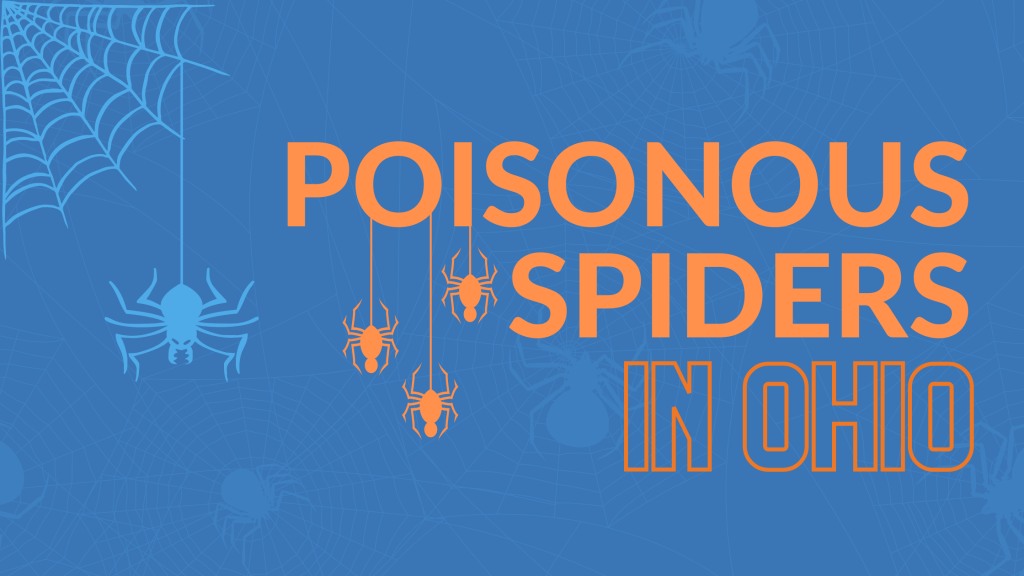
Updated: Feb 26, 2024
Whether you’re someone who loves spiders, is terrified to death of them, or you’re just someone who respects them but prefers to relocate the ones you find inside your home back outside, we should all appreciate them for what they do for us. Spiders are a significant part of nature and our own indoor ecosystems.
A lot of times, the spiders you find in your home are actually providing you with a similar service we offer as exterminators, keeping bugs and even other spiders away! Spiders regularly catch nuisance pests and even disease-carrying insects like mosquitoes. This means that killing a spider in your home doesn’t just cost a poor little arachnid it’s life, it may also be taking an important predator out of your home!
We totally get that it’s natural to fear spiders. However, a majority of the spiders we have here in Ohio are actually quite harmless. That being said, there are a few types of poisonous spiders in Ohio that you should always keep an eye out for. There are some spiders that should be welcome into your home, but the poisonous spiders below are not some of them!
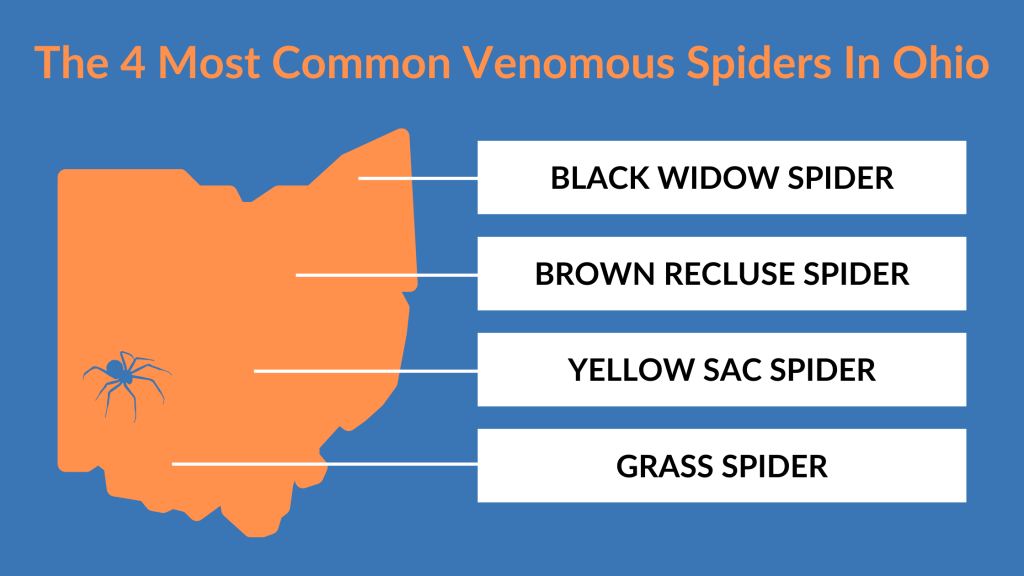
Venomous Spiders, Not Poisonous Spiders
To get technical for a moment, most spiders aren’t actually ‘poisonous’. A poison is a toxin that gets into the body via inhaling, swallowing or absorption through the skin. A venom, on the other hand, is a toxin that is injected into the body, such as through the fangs of a spider or a snake. That being said, almost all spiders are venomous, using their venom to subdue their prey. Fortunately, we are not their prey of choice and most spiders actually have fangs that are too small or short to even penetrate human skin!
When referring to ‘poisonous’ spiders in the article below, we’re actually referring to ‘venomous’ spiders. We just changed up the wording because more people search for information about ‘poisonous spiders’ rather than ‘venomous spiders’ 🙂
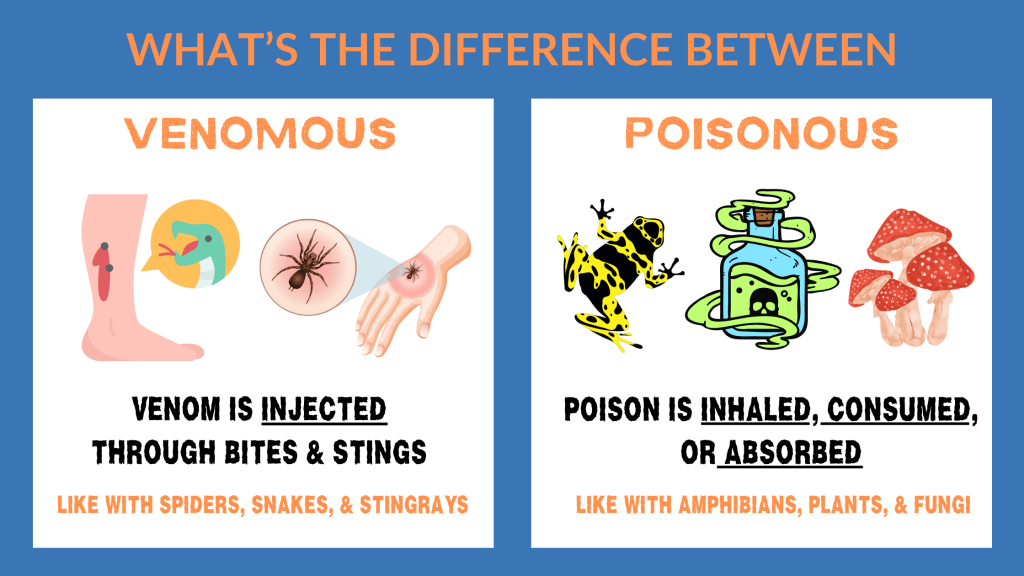
Black Widow Spider
You’re probably already well familiar with this poisonous spider! Black widow spiders have a very wide geographic distribution across the United States, including throughout Ohio. While the species vary greatly in size, being as small as the width of a pencil eraser to as large as a quarter, they’re typically identified by the signature red or orange hourglass shaped markings on the underside of their abdomens. Female black widow spiders are often darker, almost black, in color but some have lighter bodies that may appear brown or reddish.
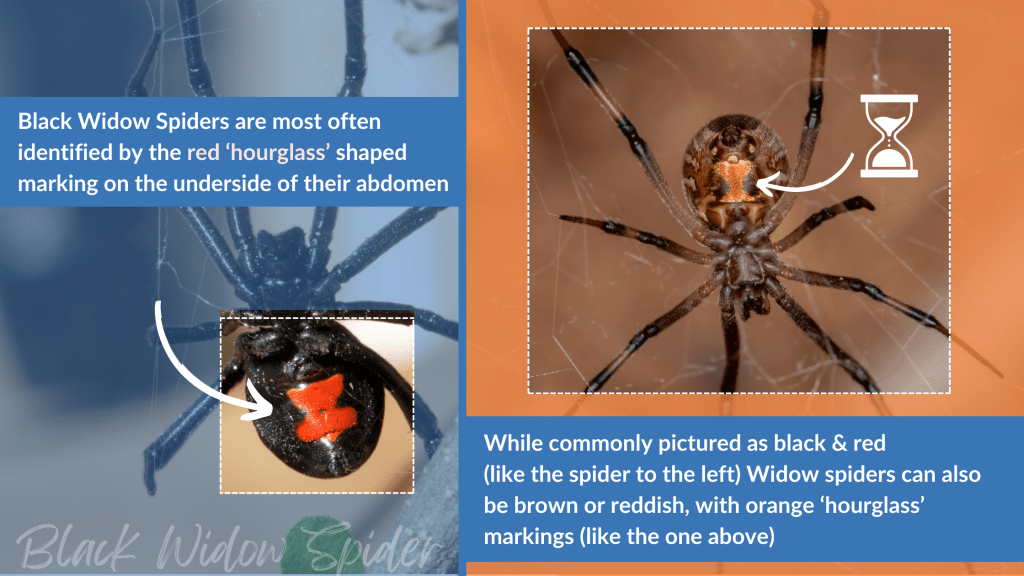
Where do Black Widow Spiders Live?
Black widow spiders usually build their webs away from humans. The prefer to hide away in abandoned or rarely used areas around your home, such as in your garage, basement, or attic.
How Toxic are Black Widow Spiders?
Black widow bites are typically immediately painful, as the venom’s toxin takes effect quickly. Black widow spiders bites are rarely lethal in healthy adults, however children, the elderly and people with comprised immunity are more at risk for complications.
Symptoms of a Black Widow Spider Bite may include:
- 1-2 little fang marks that look like tiny red spots at the site of the bite
- Cramping, muscle spasms and achiness that starts near the bite and then spreads and progressively gets worse after about 6-12 hours
- Nausea (feeling sick to your stomach) or vomiting
- Severe stomach, back or chest pain
- Fever and/or chills
- Excessive sweating
- Headache
- Signs of shock, such as restlessness or stupor
- Sudden high blood pressure
What to do if you’ve been bitten by a Black Widow Spider
- Try to remain calm and stay relaxed. Avoid excessive movement or excitement to avoid increasing the flow of venom into your bloodstream.
- Seek medical attention immediately by calling your doctor or local poison control center. The national, toll-free, Poison Help line 1-800-222-1222 connects you to your local poison center.
- Immediately clean the bite area with soap and water. Apply a clean damp cloth (towel) with cold water or ice to the bite area to help reduce swelling and alleviate the discomfort. Seek medical attention for severe symptoms.
- Keep an eye out for any other symptoms that may develop, progress, or change as the bite progresses or heals
(Brown) Recluse Spiders
Two species of recluse, the common brown recluse and the Mediterranean recluse, can be found in Ohio. They are usually between ¼” to ½” long. Their bodies are often light brown with a distinct dark colored violin or fiddle shape on their backs, near their head.

Where do Brown Recluse Spiders Live?
Recluse spiders are, as their name suggests, reclusive and tend to hide away in dark, infrequently traveled areas of a home. They can typically be found inside buildings, especially in the cooler months. They also like to seek shelter in woodpiles and stagnant leaf piles, just outside your home.
How toxic are brown recluse spiders?
If bitten by a recluse, you might not experience immediate pain. The days following a bite, however, the toxin in the spider’s venom can cause skin tissue around the bite to die (also known as necrosis). This is usually the most obvious sign that the bite came from a brown recluse and not another poisonous spider.
Signs of a brown recluse spider bite include:
- Reddened skin, as well as bruising and swelling
- A blister that forms at the site of the bite
- Mild to intense pain and/or itching 2-8 hours following the bite
- Pain that continues to increase in severity hours or days after the initial bite
- An open sore (ulcer), indicating the breakdown of tissue (necrosis)
Note: This symptom may develop a week or longer after the initial bite – seek medical attention immediately - A wound that drains cloudy liquid
Note: This symptom can be an indication of a more serious infection – seek medical attention immediately - Fever and/or chills
- A full-body skin rash with many tiny flat red and/or purple spots
- Joint pain and/or stiffness
- Nausea (feeling sick to your stomach) or vomiting
- Pain in your abdomen, back, chest and legs
- Restlessness or difficulty sleeping
- Dizziness
What to do if you’ve been bitten by a recluse spider
- Try to remain calm and stay relaxed. Avoid excessive movement or excitement to avoid increasing the flow of venom into your bloodstream.
- If you experience any severe symptoms, seek medical attention immediately
It can be difficult to identify a recluse spider bite unless you actually saw the spider bite you, especially since the bite isn’t often felt until hours after the bite occurred when other symptoms begin to occur. If you suspect a reclusive spider bite, call a healthcare professional or visit the emergency room and, if possible, try to bring the spider with you for proper identification. - Immediately clean the bite area with soap and water. Apply a clean damp cloth (towel) with cold water or ice to the bite area to help reduce swelling and alleviate the discomfort. Seek medical attention for severe symptoms.
- Keep an eye out for any other symptoms that may develop, progress, or change as the bite progresses or heals
Stages of a Brown Recluse Spider Bite
According to the Cleveland Clinic, these are some common stages that someone may experience if bitten by a brown recluse spider.
- Hours after the bite – The area of bite may become red and sensitive to touch. The bite site may feel like it’s burning or stinging and may change color, either bruising to a blueish color or appearing to look patterned like a ‘bullseye’. The person may experience one of the above listed signs of a brown recluse spider bite. Medical attention should be sought as soon as possible.
- 3-5 Days after the bite – If the venom of the spider has spread, discomfort may continue and an ulcer may appear.
- 7-14 Days after the bite – In severe cases, the skin around the ulcer may begin to break down, becoming a wound that can take several months to completely heal.
- 3 Weeks after the bite – Most bites heal after this time, with a thick, black scab covering the wound.
Yellow Sac Spider
The yellow sac spider is less than ½” long. It has a light colored body that is typically yellow, as their name suggests, however they can range in color from tan, light brown, to even pale green depending on their location and diet. They are nocturnal and typically hide during the day.

Where do Yellow Sac Spiders Live?
These albino-looking spiders are most often found in homes, high up on walls or ceilings. Yellow sac spiders are a more aggressive species of spiders than black widows or brown recluse. They will bite immediately and often repeatedly when threatened!
How toxic are Yellow Sac Spiders?
If bitten by a yellow sac spider, the bite or bites may be painful, with a small red bump forming soon after that will typically fade after a couple of weeks. For most people, the yellow sac spider bite is not deadly. That being said, some people experience swelling, burning, and intense pain that can result in a serious but very uncommon skin infection.
Signs of a Yellow Sac Spider Bite include:
- Redness, swelling, and burning sensation at the site of the bite
- Headache
- Nausea or vomiting
What to do if you’re bitten by a Yellow Sac Spider
- Immediately clean the bite area with soap and water. Apply a clean damp cloth (towel) with cold water or ice to the bite area to help reduce swelling and alleviate the discomfort.
- Call a medical professional for treatment advice if you experience nausea, vomiting, headache, or other, more severe, symptoms.
Grass Spider
Grass spiders can typically be identified by their medium brown coloring and signature dark brown stripes on their backs. They’re also recognizable by the distinct “chevron” looking patterning down their abdomens.
Where do Grass Spiders Live?
They typically build a funnel shaped web in lush grassy lawns but will resort to building webs in indoor crevices when the cold drives them inside.
How toxic are Grass Spiders?
Technically, grass spiders are not poisonous but they are venomous. Like all spiders, they contain venom that they use to subdue their prey. Luckily for us, they (like a lot of other spiders) have small fangs that have trouble penetrating human skin. Unfortunately, certain groups of people with thinner skin (like babies, elderly, and people with certain skin conditions) are a greater risk when it comes to getting bit by a grass spider.
Signs of a Grass Spider Bite include:
- Redness or swelling around the bite
- Itching or rash
- Skin blistering
- Headache
- Nausea or vomiting
- An open sore (ulcer), indicating the breakdown of tissue (necrosis) – this typically develops a week or more after the bite
What to do if you’ve been bitten by a Grass Spider
- Try to remain calm and stay relaxed. Avoid excessive movement or excitement to avoid increasing the flow of venom into your bloodstream.
- Immediately clean the bite area with soap and water. Apply a clean damp cloth (towel) with cold water or ice to the bite area to help reduce swelling and alleviate the discomfort. Seek medical attention for severe symptoms.
A grass spider bite can be serious and may require immediate medical attention. Call a doctor ASAP if you experience any of the above severe symptoms throughout your body or an open sore and/or necrosis (black, dead tissue) develop.
Preventing Poisonous Spider Bites
There are some steps you can take to avoid coming into direct contact with poisonous spiders and avoiding bites altogether.
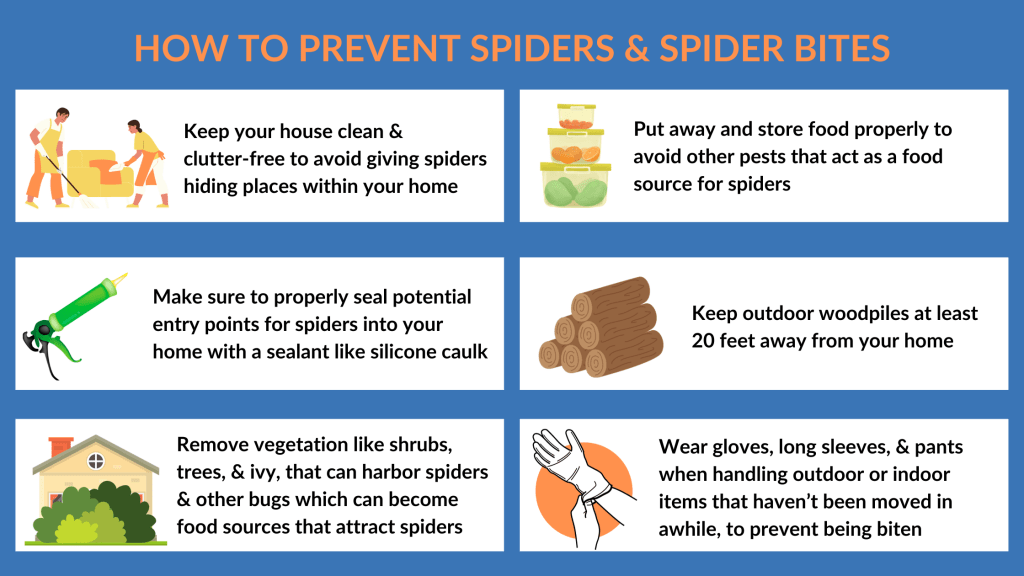
- Prevent poisonous spiders from getting into your home by being diligent about sealing small openings around your home that lead outdoors with a sealant like caulk.
- Keep and maintain (repair/replace) mesh screens around your windows, doors, and exhaust vents.
- Clean throughout your home, regularly and thoroughly. A clean, clutter free home helps prevent hiding places for poisonous spiders to live within your home. Put away food and be mindful of fruit left out on the counter that can attract fruit flies and other pests that provide a consistent food source for spiders.
- Remove spider webs from your home as you find them. This will help keep the spiders from feeding and help force them to relocate back outside. Check in areas around your home where you and your household members don’t spend as much time for webs – like in attics, basements, and other common storage areas.
- Keep outdoor lights on the immediate exterior of your home off to avoid attracting moths and other bugs that can be another food source for poisonous spiders. Also check around and behind doors with outside entry for conveniently located webs used by spiders to catch other pests flying in and out of your home.
- Keep outdoor firewood piles at least 20′ away from your home. Remove or cut back vegetation within at least 8′ of the perimeter of your home. Decorative shrubs, trees, ivy, and other plants may look pretty but they can provide shelter for spiders, as well as harbor other insects that spiders eat. Keeping firewood and other vegetation away from the immediate exterior of your home is also good practice for helping to prevent termites, too!
- When handling outdoor or indoor items that haven’t been moved in awhile (such as when moving firewood indoors, handling or cutting vegetation, rearranging items in your garage, or moving around boxes or other items in storage), be sure to wear long sleeves, pants, and gloves. If you do come across any spiders, you’ll be protected against any potential bites against direct skin.
- If you notice multiple poisonous spiders crawling around your home, you may want to consider an external protective barrier method, like a Body-Guard treatment plan to help repel and kill poisonous spiders, ants, wasps, mosquitoes, termites, and other pests. Contact go2-pros pest control for more information about prevention and treatment against poisonous spiders.
Need Help Identifying A Spider?
For help identifying spiders and other bugs around your home, we recommend using this helpful “What Bug Is This?” tool from our friends at PestWorld. You can also reach out to our local pest control technicians for help identifying a spider in your home to ensure you don’t have an infestation of potentially poisonous spiders!
Our pest control team also specializes in preventative treatment plans to help keep spiders out of your home. Call today to learn more about our Body-Guard Pest Control Plans, designed to repel poisonous spiders and other pests.
